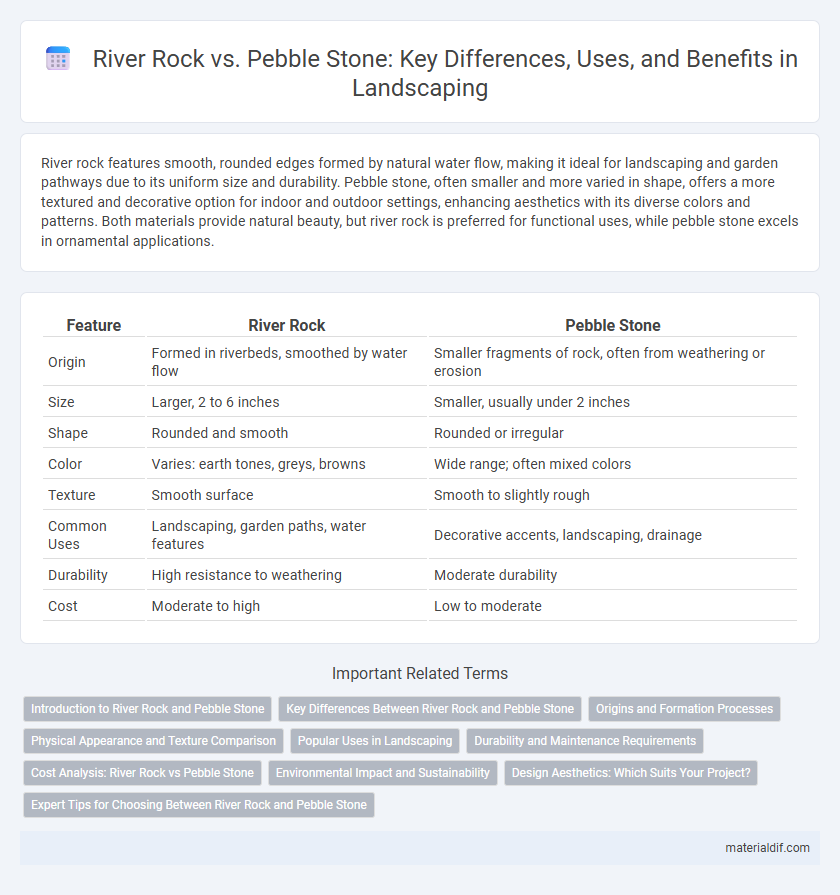River rock features smooth, rounded edges formed by natural water flow, making it ideal for landscaping and garden pathways due to its uniform size and durability. Pebble stone, often smaller and more varied in shape, offers a more textured and decorative option for indoor and outdoor settings, enhancing aesthetics with its diverse colors and patterns. Both materials provide natural beauty, but river rock is preferred for functional uses, while pebble stone excels in ornamental applications.
Table of Comparison
| Feature | River Rock | Pebble Stone |
|---|---|---|
| Origin | Formed in riverbeds, smoothed by water flow | Smaller fragments of rock, often from weathering or erosion |
| Size | Larger, 2 to 6 inches | Smaller, usually under 2 inches |
| Shape | Rounded and smooth | Rounded or irregular |
| Color | Varies: earth tones, greys, browns | Wide range; often mixed colors |
| Texture | Smooth surface | Smooth to slightly rough |
| Common Uses | Landscaping, garden paths, water features | Decorative accents, landscaping, drainage |
| Durability | High resistance to weathering | Moderate durability |
| Cost | Moderate to high | Low to moderate |
Introduction to River Rock and Pebble Stone
River rock and pebble stone are naturally smooth, rounded stones formed by the continuous flow of water in rivers and streams, creating their distinct polished appearance. River rock typically ranges from small pebbles to larger cobbles, featuring a variety of colors influenced by minerals and sediment composition. Pebble stone is generally smaller, often less than 2.5 inches in diameter, and prized for its uniform size and smooth texture, making it ideal for landscaping and decorative applications.
Key Differences Between River Rock and Pebble Stone
River rock features smooth, rounded edges formed by natural water erosion over time, lending a polished and uniform appearance ideal for landscaping and garden pathways. Pebble stone varies more in size and shape, often less uniform with sharper edges, making it suitable for decorative purposes such as aquariums and craft projects. The density and weight of river rock are generally higher than pebble stone due to its natural compaction and mineral composition.
Origins and Formation Processes
River rock forms through the natural weathering and erosion of larger stones within riverbeds, where continuous water flow smooths and rounds the edges over time. Pebble stones are smaller, typically derived from various rock types that have been broken down by physical and chemical weathering, often found in gravel deposits or along shorelines. The key difference lies in river rock's specific aquatic origin and abrasion process, contrasting with pebbles' broader formation environment.
Physical Appearance and Texture Comparison
River rock exhibits smooth, rounded surfaces with a consistent size ranging from medium to large, creating a polished and natural look ideal for landscaping. Pebble stone is smaller, often irregularly shaped, with a rougher texture that adds a rustic, varied aesthetic suitable for pathways and decorative features. The tactile difference between river rock's sleek finish and pebble stone's granular feel influences their functional and visual applications in design.
Popular Uses in Landscaping
River rock is commonly used in landscaping for creating natural-looking pathways, garden borders, and water features due to its smooth texture and larger size. Pebble stone, with its smaller size and rounded shape, is ideal for ground cover, mulching, and decorative garden beds, providing good drainage and a polished appearance. Both materials enhance outdoor spaces by adding texture and contrast, but river rock offers more durability for high-traffic areas while pebble stone excels in aesthetic versatility.
Durability and Maintenance Requirements
River rock exhibits superior durability due to its dense composition and natural resistance to weathering, making it ideal for high-traffic outdoor applications. Pebble stone, while aesthetically appealing and smooth, typically requires more frequent maintenance to prevent surface wear and accumulation of dirt. Choosing river rock significantly reduces upkeep efforts and extends the lifespan of landscaping or construction projects.
Cost Analysis: River Rock vs Pebble Stone
River rock typically costs between $0.50 and $2.00 per pound, making it a more expensive option compared to pebble stone, which ranges from $0.30 to $1.50 per pound. The higher cost of river rock is due to its smoother texture and natural water-polished finish, often requiring more labor in sourcing and transportation. Budget-conscious projects may prefer pebble stone for its affordability and similar aesthetic appeal in landscaping applications.
Environmental Impact and Sustainability
River rock and pebble stone differ significantly in environmental impact and sustainability due to their sources and processing methods. River rock is often harvested directly from riverbeds, which can disrupt aquatic ecosystems and water quality, whereas pebble stone is typically collected from coastal or glacial deposits, minimizing habitat disturbance. Pebble stones usually require less processing energy and produce lower carbon emissions, making them a more sustainable choice for landscaping and construction projects focused on reducing environmental footprints.
Design Aesthetics: Which Suits Your Project?
River rock offers smooth, naturally rounded shapes with varied earth tones that enhance rustic and organic design aesthetics, making it ideal for creating tranquil garden pathways or water features. Pebble stone features smaller, uniform sizes and a polished surface that provide a sleek and modern look, perfect for contemporary landscaping or minimalist interior accents. Choosing between river rock and pebble stone depends on whether the project requires a natural, rugged texture or a refined, clean visual appeal.
Expert Tips for Choosing Between River Rock and Pebble Stone
River rock offers smoother, rounded shapes with natural color variations ideal for landscaping projects requiring a polished, organic look. Pebble stone tends to be smaller, more uniform, and often used for decorative pathways or ground cover where subtle texture and consistency matter. Experts recommend assessing project scale, drainage needs, and aesthetic goals to determine the best option between durable river rock and versatile pebble stone.
River Rock vs Pebble Stone Infographic

 materialdif.com
materialdif.com